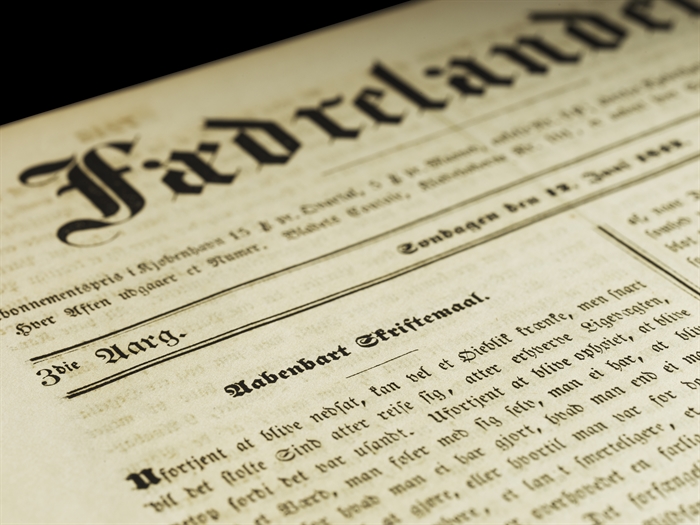EXCEEDINGLY SCARCE FIRST PRINTING OF KIERKEGAARD'S FRIST PAPER IN "THE FATHERLAND"
KIERKEGAARD, SØREN.
Aabenbart Skriftemaal. [Printed in: Fædrelandet 3die Aarg. Nr. 904. Søndagen den 12. Juni 1842, edt. Giødwad].
(København), 1842.
Large 4to (32 x 24, 8 cm). 2 columns to a page. Columns (7545)-7252, all containing Kierkegaard’s article. 2 ff.
The exceedingly scarce original printing of the leaves of The Fatherland that contain Kierkgaard’s first publication in the paper, in which he would print all of his other newspaper-articles. AABENBART SKRIFTEMAAL is Kierkegaard’s first article in the paper Fædrelandet (The Fatherland), a paper that will later become of seminal importance to him and to Danish polemics in general. It also constitutes his fifth newspaper article, the first to appear after his earliest publications in Kjøbenhavns Flyvende Post, which were published before any of his books, and the first article pertaining to his pseudonymity. Kierkegaard kept returning to Aabenbart Skriftemaal, eg. in an unpublished article that he wrote in 1843, Opfordring, and also several years later, in his Journal (NB6:16), where he denotes Aabenbart Skriftemaal as a “signal shot” – a signal shot for the forthcoming period of his authorship, the pseudonymous period, that begins with Either-Or. Though the present paper is among Kierkegaard’s earliest writings, we already witness the distinct attitude to his authorship that would become so defining for his career. His earliest articles, although pseudonymously published, had been attributed to Kierkegaard, and he uses the present paper to refuse taking ownership of papers he had not published in his own name. “Thus “Public Confession” is noteworthy because it indicates just how early Kierkegaard shaped his authorial purpose.” (D. Anthony). “...I beg the good people who show an interest in me never to regard me as the author of anything that does not bear my name” (from Aabenbart Skriftemaal). Fædrelandet – litterally translated as ”The Fatherland” – was a Danish newspaper that was founded in 1834 and existed until 1882. In the beginning it appeared weekly, but in 1839, it began appearing daily. With its cultural and political contents, it soon became the leading paper of the national liberal opposition. The paper was the most important paper in Kierkegaard’s time and the one that more than any other influenced public opinion. During the first years of its existence, the paper had numerous different publishers and editors. It also ended up in numerous controversies with the censorship authorities, resulting in many trials and fines. From May 1841, the editors of the paper were Carl Ploug and J.F. Giødwad. The latter would come to play an enormous role in Kierkegaard’s authorship, as would The Fatherland itself. Giødwad was one of the very few people that Kierkegaard has ever characterized as a “personal friend” (SKS 21 214,10). It is very likely that this friendship was initiated in 1842, when Kierkegaard published his first paper in The Fatherland, Aabenbart Skriftemaal. We know that from the Christmas of 1842, Giødwad helps with the proof reading of Either-Or and is thus clearly one of the most trusted people in his life. As we shall see later, it was also Giødwad, who represented Kierkegaard in dealings with publishers and printers, when it had to do with the pseudonymous writings, thus protecting Kierkegaard’s pseudonymity and shielding him from the public. Giødwad himself said that Kierkegaard initially got a favourable impression of him when at some point he had dismissed a reader, who wished to know who was behind an anonymous paper published in The Fatherland (see A.D. Jørgensen’s statement from 1885 in Kirmmsee, Søren Kierkegaard truffet, p. 88). Kierkegaard trusted Giødwad completely, and thereby also The Fatherland. Apart from his four earliest papers in Kjøbenhavnsposten (see nr. 1 above), The Fatherland was the only paper Kierkegaard would publish in. During its entire existence, The Fatherland would be published in ca 2.000 copies, making it of the utmost scarcity today. Almost all copies of it have been destroyed, thrown out, worn, etc., and it is extremely rare on the market. The few issues we have at the moment are the only ones from this period that we have ever seen for sale. Himmelstrup: 15 The present copy is no. 12 in Girsel's "Kierkegaard" (The Catalogue) which can be found here.
Order-nr.: 62124


![Aabenbart Skriftemaal. [Printed in: Fædrelandet 3die Aarg. Nr. 904. Søndagen den 12. Juni 1842, edt. Giødwad].](/images/product/62124a.jpg)